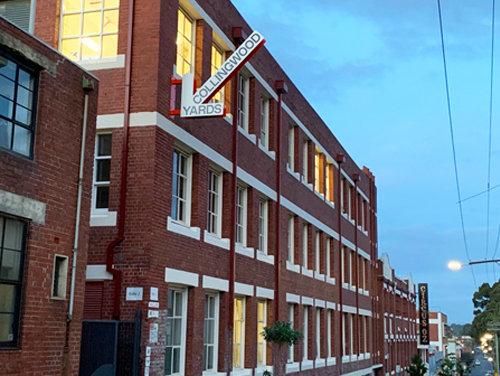‘Quarantrees’, virtual tours: The life of a locked down artist

A ‘quarantree’ by artist Carla O’Brien on the shores of Melbourne’s Albert Park Lake (Carla O’Brien)
Heard of a ‘quarantree’?
If not, you’re probably not locked down in Melbourne.
But for others, Carla O’Brien’s quarantrees have become an international symbol of Australia’s city with the highest COVID infection and death rates.
“I felt compelled to create something inspiring and relevant, and spread the message of wearing a mask in a joyful and light-hearted way without disrespecting the severity of the pandemic and its implications,” says the visual artist, who created the quarantrees that line the city’s walking tracks at Albert Park Lake and “The Tan” (the path around the Royal Botanic Gardens).
The re-opening roadmap announced by the Victorian government last weekend has given some certainty to businesses and families, but the city’s five million residents are still looking for new sources of meaning and hope as they face a few more weeks of “Stage 4” restrictions and indoor life.
For some Melburnians, weeks of having parks, libraries, galleries, shops and anything else outside a 5km radius of home off limits has seen them embrace a simpler life. For others, art has become more important than ever as a way of interpreting the world, even if it’s just kids’ drawings and messages of encouragement in house windows for passers-by on their permitted two hours of daily exercise.
O’Brien, who specialises in large-scale light installations for festivals and events, says while the majority of her forward work was cancelled or postponed when the pandemic hit, her creative juices didn’t stop just because of lockdown.
“Art is society’s great equaliser and can educate people on almost anything,” she says.
“Galleries – like pretty much everything else – are closed in Melbourne, so nature and the art that’s already around us is all we have left. We can take both for granted, so enjoying and appreciating what we have in the here and now has become even more important and meaningful.”
Together with hospitality, education, tourism and major events, the arts sector has been one of the hardest-hit sectors by the lockdowns and restrictions to contain the virus. Since mid-March, arts and recreation services jobs have been the second most impacted, down 14.3 per cent across the country, according to the ABS’s weekly payroll data.
For Melbourne’s newest arts hub, the Bank of Melbourne-backed Collingwood Yards (formerly Collingwood Arts Precinct), a new network of artists and makers were just getting to know each other when the restrictions hit.

After an 18-month build, Collingwood Yards hangs out its shingle. (Jacquelin Low)
Collingwood Yards, which has been part of the inner-city suburb for a century and a half under a few guises, was vacant for a decade until the Victorian government’s body for the creative industries, Creative Victoria, handed it over to the social enterprise Contemporary Arts Precincts to create a home for artists, creatives and arts organisations priced out of the inner city.
Contemporary Arts Precincts CEO and Westpac Social Change Fellow Marcus Westbury says despite the hit from COVID, the heart of the Collingwood Yards concept is stronger than ever. It’s about creating a dynamic community operating from the former classrooms and school halls converted into affordable artist studios and retail, hospitality and gallery spaces.
“We haven’t just built an isolated arts precinct – we’ve created a tenant community that’s very much connected to the broader neighbourhood, City of Yarra, and Melbourne creative communities,” he says.
“COVID might have delayed the big public opening we’d planned, but it hasn’t stopped our tenants creating. In some ways, it’s forced us to get more creative about inviting a wider audience to experience Collingwood Yards.”
Even before COVID-19, Collingwood Yards laid claim to a rich history.
A rare outdoor mural by pioneering American graffiti artist Keith Haring, which helped save the site from becoming one of the residential or commercial developments in the now-fashionable city fringe suburb, still remains today, greeting visitors to the Johnston Street entrance.
The story goes that Haring painted it on a whim during a teaching visit to Collingwood Tech in 1984. After hiring a cherry picker and picking up a few tins of paint from the local hardware store, Haring painted it with the help of some starstruck teaching staff and students – and a ghetto blaster blaring in the background.
Graffiti artist Keith Haring painting the mural at Melbourne’s Collingwood Tech in 1984. (ABC, Keith Haring Uncovered)
Describing the experience after he finished painting, Haring said: “I had fun. I mean, it’s the most fun I’ve had since I’ve been here. It’s more fun working here than it is inside a museum [and] it’s the only permanent thing I did while I was in Australia”.
Fast forward almost 40 years and while Collingwood Yards’ hive of activity might have been decentralised, it hasn’t dimmed: from ethical PPE being produced by fashion social enterprise The Social Studio to Bad Apples Music supporting Indigenous start-ups and micro-businesses with virtual seminars.
In addition, Collingwood Yards’ output has become even more accessible, whether a virtual tour for this year’s Open House Melbourne or global live-streamed light installations by resident projection artists in partnership with New York’s HoloCenter.
Let’s face it, with at least a few weeks before Melbourne’s allowed out again, slowing down and tuning in to something that nourishes the soul isn’t the worst way to pass the lockdown hours.


